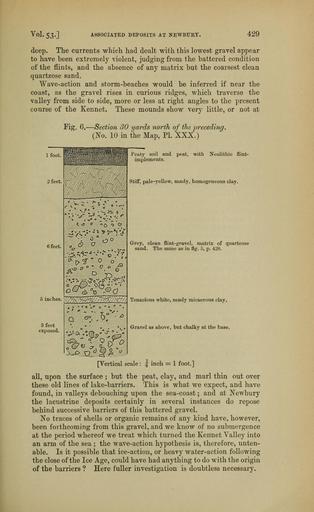MAKE A MEME
View Large Image

| View Original: | The_Quarterly_journal_of_the_Geological_Society_of_London_(12893724993).jpg (1253x2042) | |||
| Download: | Original | Medium | Small | Thumb |
| Courtesy of: | commons.wikimedia.org | More Like This | ||
| Keywords: The Quarterly journal of the Geological Society of London (12893724993).jpg Vol 53- <br> ASSOCIATED DEPOSITS AT NEWBURY <br> 429 <br> deep The currents which had dealt with this lowest gravel appear <br> to have been extremely violent judging from the battered condition <br> of the flints and the absence of any matrix but the coarsest clean <br> quartzose sand <br> Wave-action and storm-beaches would be inferred if near the <br> coast as the gravel rises in curious ridges which traverse the <br> valley from side to side more or less at right angles to the present <br> course of the Kennet These mounds show very little or not at <br> Kg 6 <br> 1 foot <br> 2 feet <br> 6 feet <br> 5 inches <br> 3 feet <br> exposed <br> ”Section 30 yards north of the preceding <br> No 10 in the Map PL XXX <br> Peaty soil and peat with Neolithic flint- <br> implements <br> Stiff pale-yellow sandy homogeneous clay <br> G-rey clean flint-gravel matrix of quartzose <br> sand The same as in fig 5 p 428 <br> Tenacious white sandy micaceous clay <br> Gravel as above but chalky at the base <br> Vertical scale 5 inch 1 foot <br> all upon the surface ; but the peat clay and marl thin out over <br> these old lines of lake-barriers This is what we expect and have <br> found in valleys debouching upon the sea-coast ; and at Newbury <br> the lacustrine deposits certainly in several instances do repose <br> behind successive barriers of this battered gravel <br> No traces of shells or organic remains of any kind have however <br> been forthcoming from this gravel and we know of no submergence <br> at the period whereof we treat which turned the Kennet Valley into <br> an arm of the sea ; the wave-action hypothesis is therefore unten- <br> able Is it possible that ice-action or heavy water-action following <br> the close of the Ice Age could have had anything to do with the origin <br> of the barriers Here fuller investigation is doubtless necessary 36029252 111130 51125 Page 429 Text 53 http //www biodiversitylibrary org/page/36029252 1897 Geological Society of London Biodiversity Heritage Library The Quarterly journal of the Geological Society of London v 53 1897 Geology Periodicals Smithsonian Libraries bhl page 36029252 dc identifier http //biodiversitylibrary org/page/36029252 smithsonian libraries Information field Flickr posted date ISOdate 2014-03-03 Check categories 2015 August 26 CC-BY-2 0 BioDivLibrary https //flickr com/photos/61021753 N02/12893724993 2015-08-26 16 57 24 cc-by-2 0 PD-old-70-1923 The Quarterly journal of the Geological Society of London 1897 Photos uploaded from Flickr by Fæ using a script | ||||